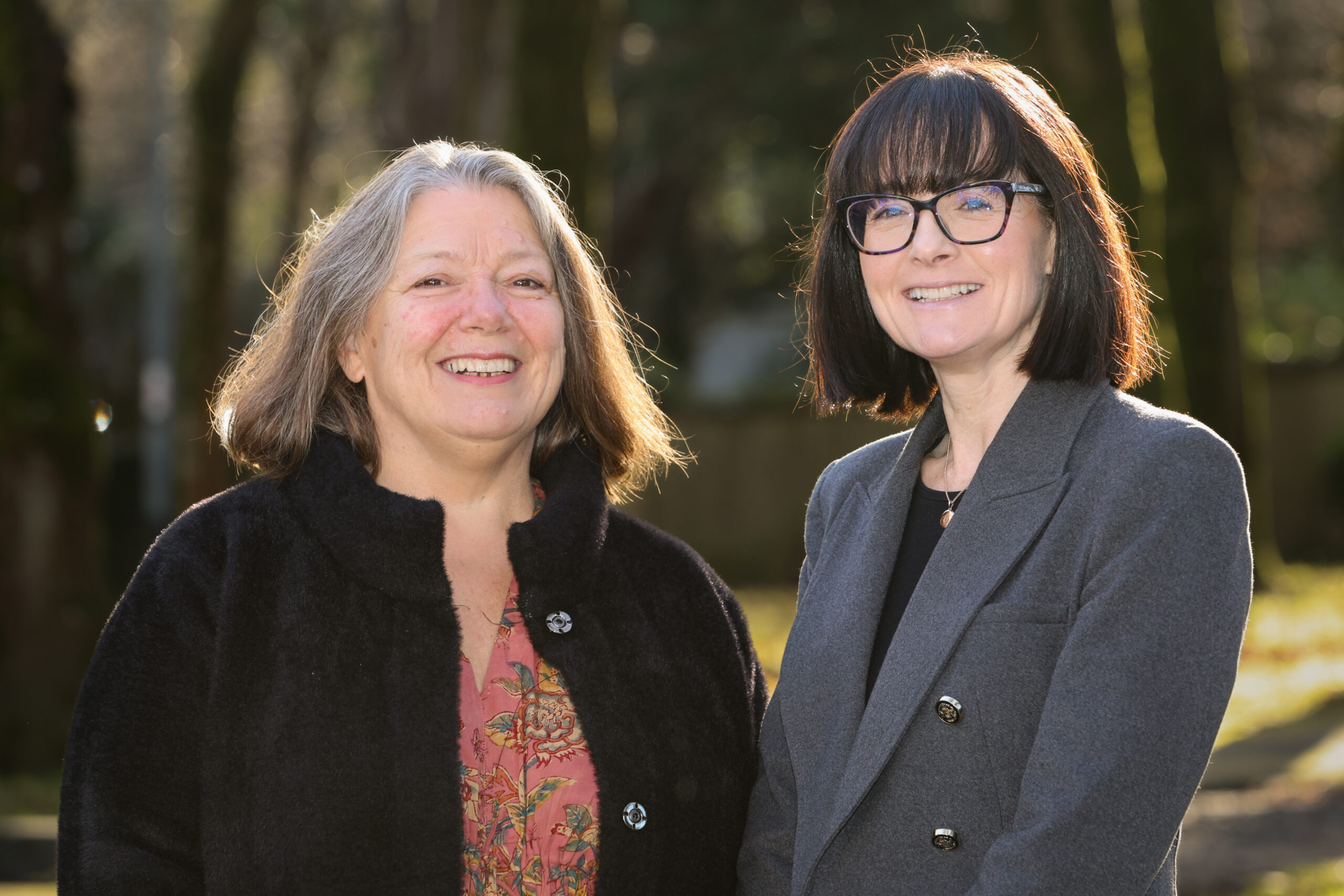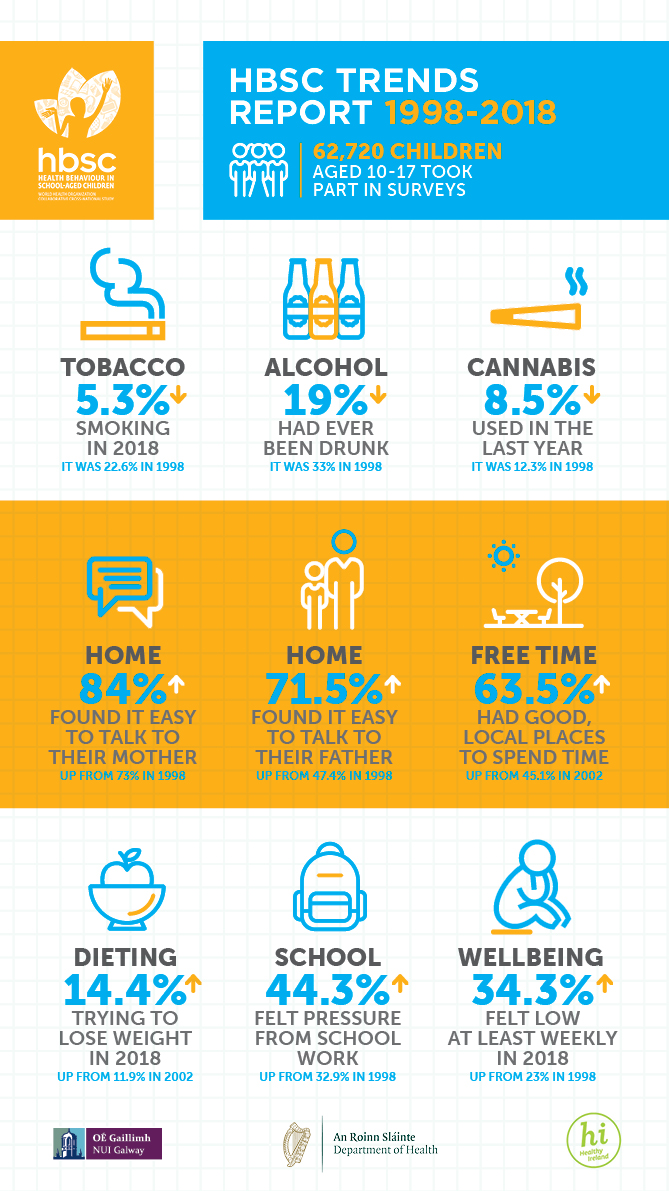
In this article, Cois Coiribe connects with Prof Colette Kelly and Prof Saoirse Nic Gabhainn, both Personal Professors of Health Promotion at University of Galway. They lead the University‘s Health Behaviour in School-aged Children (HBSC) Ireland team, based in the Health Promotion Research Centre, a World Health Organization Collaborative Centre. Founded in 1990, the Centre is now based in the School of Health Sciences, College of Medicine, Nursing and Health Sciences.
Over the last 30 years, University of Galway has made major contributions to research in child and adolescent health policy and practice through the Irish HBSC study. This national study has been repeated seven times, every four years since 1998. Over time, it has had a substantial impact on policy and strategy around children’s and young people’s health and wellbeing. As a long-term project, it has established, monitored and shaped national indicators of child health. Through the Irish HBSC team’s leadership, it has significantly enhanced youth participation in European policy making.

The 1990s were a decade of change, and the precipice of those 10 years saw the turning of a century. This was something novel to most of the population. We were experiencing mass access to the internet for the first time, its use becoming commonplace in the home nearing the end of the 90s, and the vision of family and success was changing as we headed into the 2000s. We also felt the waning of conflict, and the years of the early noughties brought a sense of hope.
“The early studies were a real discovery, documenting for the first time the differences between girls and boys, across social classes and between age groups. Uncovering evidence of how the context of children’s lives was related to their health was really fascinating” – Prof Saoirse Nic Gabhainn.
The HBSC Ireland study now encompasses the thoughts and contributions of 82,000 children but, back in 1998, its first year of collection, it included the voices of 8,497 children for the first time. Before this, there was little evidence available on children’s health and wellbeing across the nation. This new effort documented the context and patterns of children’s health in Ireland, its efforts blooming into invaluable insights over the years to come.
HBSC is an international collaboration and, in 1998, research teams in 27 countries across Europe and North America took part. Now, the International HBSC network spans 51 countries from Canada to Kazakhstan and Greenland to Cyprus. The network has also grown to include linked projects undertaken in Africa, Asia, South America and Australia. The European office of the World Health Organization collaborates closely with the network. Data from these studies is crucial to understanding young people’s health, tracking changes over time, and highlighting new issues, thereby contributing to the decision-making efforts of governments, NGOs, community groups and schools.
Every four years, school children ranging in age from 9 to 18 years across Ireland are invited to participate in the HBSC survey. With consent from the appropriate guardians, these children and adolescents complete a series of questions that record the pulse of the modern adolescent health landscape. Once only collected in paper format, a new avenue opened with online access, and this often presents the contemporary medium of data collection, with students typing their answers and clicking a submit button to document history.
“It is important to ensure that the schoolchildren taking part are representative of all schoolchildren in the country. Schools decide whether to use paper questionnaires or to take part online. The online option takes a lot of work to prepare in advance but saves time afterwards as the responses are delivered without delay to our computers in the University” – Prof Colette Kelly
Each survey round starts with agreeing core questions, decided in collaboration between 450 researchers involved in the HBSC network. They focus on health, health behaviour and the social contexts of health, each with a strong emphasis on continuity over time. In addition to these, emerging issues are introduced during each survey round. Examples include the introduction of questions on mental health, vaping and internet use and addiction. For older children, questions on gender and sexual identity are included.
For each country, items of national interest are included in the mix. Ireland’s survey has taken steps to draw up queries that speak to evidence gaps as well as questions that respond to stakeholder needs, including those of the participating children. Efforts have been made by the HBSC Ireland team to embed youth involvement, allowing children greater influence over the shape of the questionnaire, such as deciding on topics and specific questions, and offering them opportunities to explain the findings. For example, Ireland has recently included questions on the environment based on proposals from children, questions on period poverty based on requests from the Department of Health, and questions on sun-safety behaviour based on requests from the Institute of Public Health and the Cancer Control Programme of the Health Service Executive.
HBSC Ireland has led the development of youth participation in the study and international policy. Recently, it led the inclusion of children and young people in the WHO Child and Adolescent Health Strategy for Europe (2025–2030), developing protocols during this process which other country teams could replicate to include youth in their decision-making.
Every four years, new data comes to life that paints a picture of Ireland, composed by youthful hands. Sometimes they project a positive change; other times they depict negative changes across physical, mental and social health. No matter the result, the work is defined by the contribution of voices often drowned by the louder discourse of older generations. In this study, children are at the forefront, offering insight into their current lives and the physical, emotional and digital contexts they live in.
“Over time HBSC trends have noted a reduction in smoking, drinking and cannabis use, and improvements in the context of children’s lives like being able to talk to parents and having good places to spend free time in their local area. On the other hand, there has been an increase in dieting, feeling low and feeling pressure from schoolwork over the years.” – Prof Saoirse Nic Gabhainn

Some behaviours have changed little over time, for example, 19% report never having breakfast on weekdays, and 18% report they have gone to bed or school hungry because there was not enough food at home. One of the most negative recent changes has been a substantial reduction in sexually active 15- to 17-year-olds who reported that they used a condom which was 48% in 2002 down from 62% in 2018, while those reporting using no contraception at all increased from 22% in 2018 to 34% in 2022.
New issues covered in the recent studies reveal that 10% of girls reported period poverty and 60% of girls reported not being able to go to school because of period symptoms. Also new is the information on loneliness; 15% of boys and 26% of girls reported feeling lonely all or most of the time over the past 12 months.
HBSC Ireland findings are regularly used and cited in national and international strategy and policy documents. Notably, since 2017, over national and international 100 policy documents have cited statistics and observed evidence from HBSC Ireland. Not only have the youth of Ireland shaped the construct of decades through moments frozen in time, but they have impacted research on a global scale, offering insight from the eyes of a child.
“What HBSC Ireland has achieved is remarkable, transforming our understanding of children’s health in Ireland and internationally. Collaborating with children, policy makers, schools and practitioners has been really important to providing the evidence to support action for children. Our next report on trends between 1998 and 2022 will be available in early 2025, and we hope to start the whole cycle of the study for the eighth time in winter 2025/26” – Prof Colette Kelly
Childhood and adolescence are important phases of life, particularly for learning and development, and set the stage for adulthood. Children face a range of unique challenges and opportunities in their lives, and while some of these repeat over generations, others can be completely new and confusing. HBSC Ireland’s job is to collect and use the best possible evidence to understand what affects adolescent health, and how to improve children’s lives, with a particular focus on reducing inequalities in health. The data is used to advocate for changes in policy and practice so that children can thrive in their homes, schools, neighbourhoods and communities. Continued research investment in this area is essential to understand how and why child and adolescent health changes over time and differs across economic, geographical and social settings. It’s also a crucial vehicle to continue tracking whether policy changes are working to reduce disparities in health.
By listening to children, we can understand their worlds and include their priorities in our goals to collectively build a healthier society.
Profiles